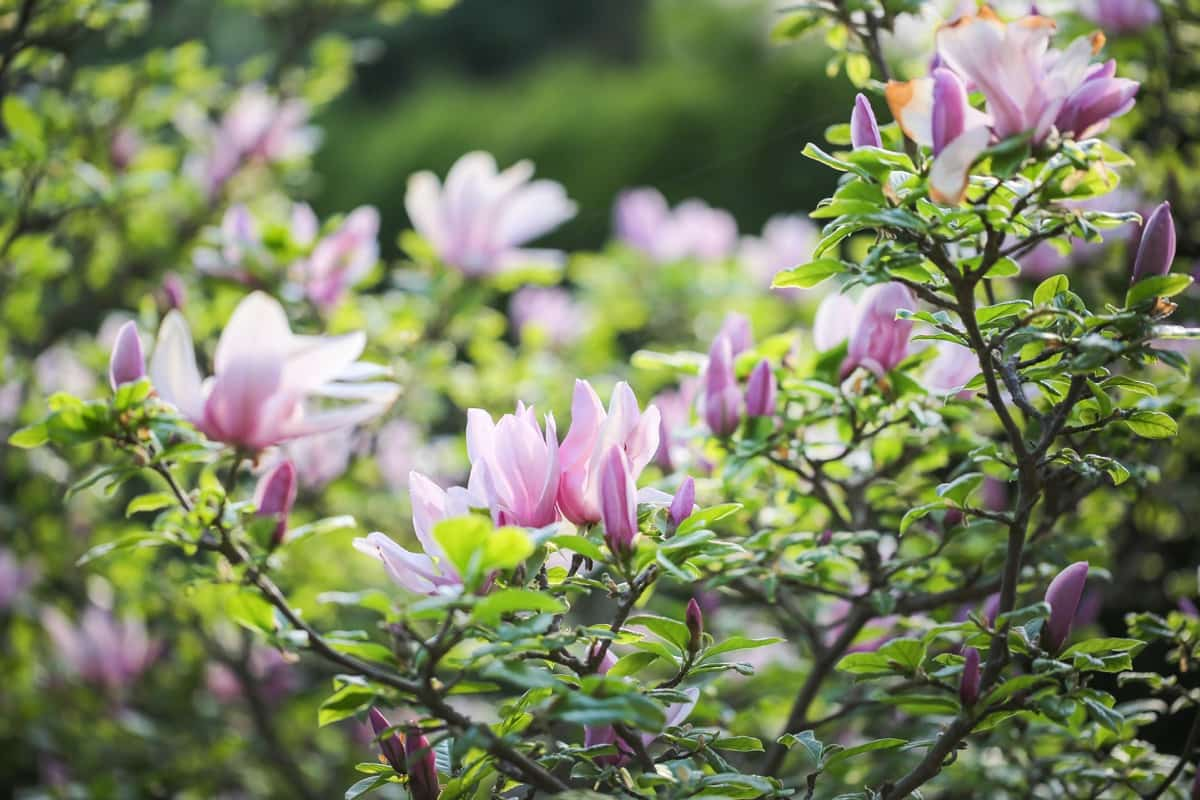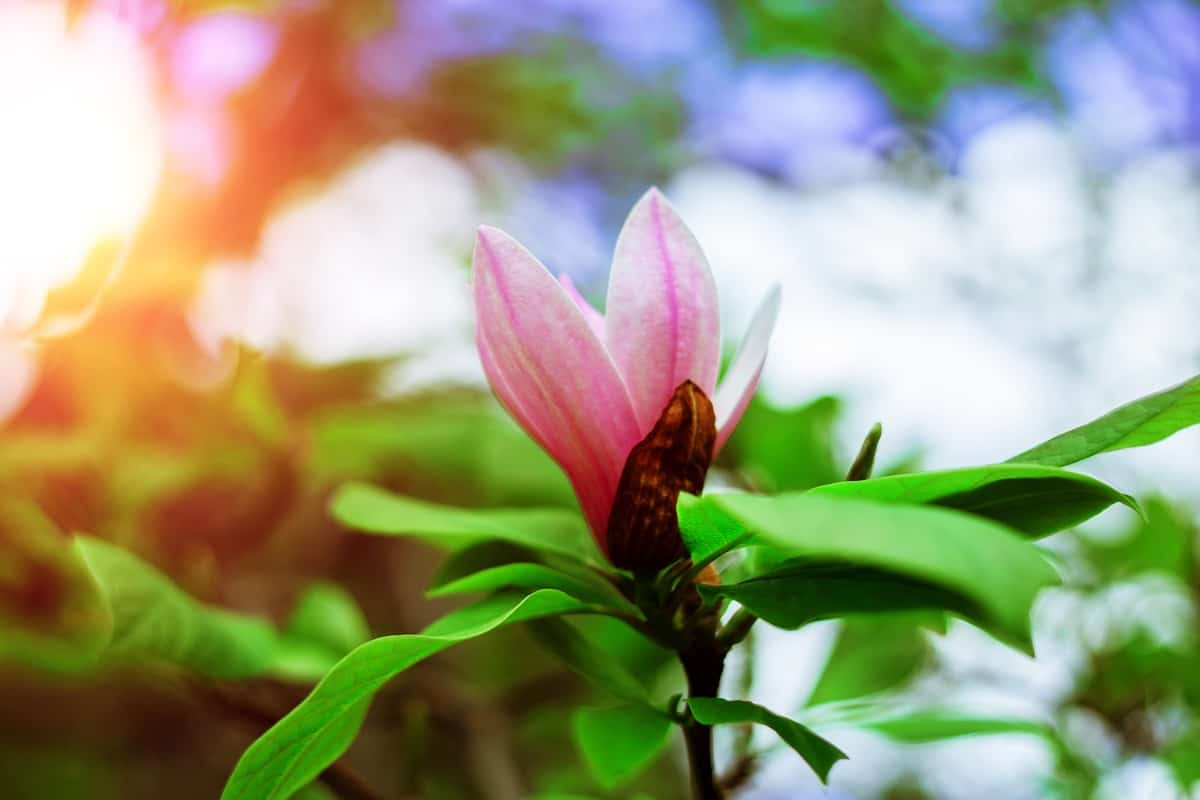Magnolia trees bloom in the early spring and have glossy green leaves. It’s a sign that something’s wrong if you see your magnolia tree leaves turning yellow and brown during the growing season. As there are many causes of yellow magnolia leaves, ranging from nutritional to natural, you need to investigate the problem with your tree. Here are some tips to help you figure out why your magnolia leaves are yellowing.

How to Treat Yellow Leaves on Your Magnolia Tree
Yellowing Magnolia Tree Leaves and Nutrient Deficiency
- Nitrogen deficiency is the most common cause of yellowing magnolia leaves. Nitrogen is one of the most important nutrients for plant growth, and a lack of nitrogen can cause leaves to turn yellow.
- Iron deficiency can also cause yellowing leaves in magnolias. Iron is necessary for photosynthesis, and a lack of iron can cause yellowing of the leaves.
- Magnesium deficiency can also cause yellowing leaves in magnolias. Magnesium is essential for chlorophyll production, and a lack of magnesium can lead to yellowing of the leaves. Symptoms of magnesium deficiency include yellowing leaves with green veins and brown spots.
Fertilizers containing nitrogen, iron, and magnesium can help prevent nutrient deficiencies and promote healthy growth. Apply the selected fertilizer according to the manufacturer’s instructions. This may involve broadcasting the fertilizer around the tree’s base or incorporating it into the soil. Be sure to water the tree thoroughly after application to help the nutrients penetrate the soil and reach the tree’s roots.
Diseases and Pests Affecting Magnolia Tree Leaves
Two of the most common diseases affecting magnolia tree leaves are Anthracnose and Powdery Mildew. Anthracnose is caused by a fungus that thrives in wet and cool weather conditions. This disease appears as dark brown or black spots on the leaves, which can grow in size and lead to the defoliation of the tree.
Powdery Mildew is a fungus-caused disease that appears as a white, talcum powder-like substance on the leaves, leading to turning yellow and falling off prematurely. Fungicides, such as copper-based products, can be applied to the leaves to prevent the spread of Anthracnose and Powdery Mildew. It is important to apply these products as soon as symptoms appear and to follow the manufacturer’s instructions carefully.
Pest Infestations
Mites: Magnolia tree leaves, and branches are a favorite food source for insects such as mites. Leaves can turn yellow with black spots if it is exposed to it. Mites may infest your magnolia tree’s branches or leaves if they appear web-like.
Scales: Scale insects eat sap from magnolia trees and attack them in large numbers. Scaly insects can cause yellowing and black spots on magnolia tree leaves and damage to its branches and bark if not addressed appropriately.
Aphids: The aphid is another tiny insect that loves to feed on magnolia leaves, causing yellowing and black spots. Aphid excrement can also be seen on the magnolia tree’s leaves and branches, which are left behind by aphids.
If the infestation persists or is severe, you can use insecticidal soap or oil to control aphids, scale insects, and mites. These products suffocate and disrupt the pests’ life cycle. Be sure to read and follow the instructions on the product label and use them according to the recommended dosage.
Watering Issues and Yellow Leaves on Magnolia Tree
Overwatering is among the most common causes of yellow leaves on magnolia trees. If the soil around the tree is constantly wet or soggy, the roots can become waterlogged and begin to rot. Yellowing and eventually falling leaves are caused by it. To prevent this, ensure your magnolia tree is planted in well-draining soil, and you are not watering it too frequently.
In case you missed it: How to Grow Magnolia Tree from Cuttings and Seed: Planting and Care Instructions

On the other hand, under-watering can also cause yellow leaves on magnolia trees. If the soil around the tree becomes too dry, the leaves can also turn yellow and fall off. To prevent this, water your magnolia tree deeply and regularly, especially during hot and dry weather.
Environmental Stress and Yellowing Magnolia Leaves
Yellowing Magnolia leaves are a common problem among gardeners and landscapers, with many possible causes. One of the most common causes of yellowing leaves is environmental stress. Various factors, including changes in temperature, humidity, and soil conditions, can cause environmental stress.
To prevent environmental stress and yellowing leaves in Magnolia trees, it’s important to maintain proper watering practices, provide adequate shade, and ensure the soil has the proper nutrients. Regular fertilization and mulching can also help to maintain healthy soil conditions and prevent stress on the tree.
Magnolia Tree Leaf Discoloration and Ph Imbalance
The soil’s pH is a measure of its acidity or alkalinity, with a pH level of 7 being neutral. Magnolia trees prefer slightly acidic soil with a pH between 5.0 and 6.5. If the soil becomes too alkaline, with a pH above 7.0, it can cause the magnolia tree’s leaves to turn yellow or brown and become brittle. To correct a pH imbalance, the soil may need to be amended. Adding organic matter like vermicompost, peat moss, or aged manure can help lower the pH level and improve nutrient uptake. Alternatively, lime or wood ash can be added to increase the pH level.
Fungal Infections and Yellow Leaves on Magnolia Tree
Leaves that have brown or black spots rimmed with yellow edges are a potential sign of a fungal disease. As it worsens or becomes more systemic, it leads to yellow leaf discoloration and drop. To prevent the condition, ensure the plant has adequate space and ventilation between plants. Also, avoid overwatering, which leads to root rot. Use a broad-spectrum fungicide to control the fungus and remove all dead or dying foliage.
Improper Pruning and Yellowing Magnolia Leaves
One of the most common causes of yellowing magnolia leaves is improper pruning. When magnolias are pruned incorrectly, it can lead to stress on the tree, which can cause the leaves to turn yellow. This stress can be caused by several factors, including cutting too much of the tree at once, cutting the tree at the wrong time of year, or cutting the tree too close to the trunk.
To prevent yellowing magnolia leaves caused by improper pruning, it is important to ensure the tree is pruned correctly. This means avoiding pruning the tree at the wrong time of year and cutting too much of the tree at once. It is also important to make any cuts at the proper angle and distance from the trunk.
Seasonal Changes and Yellow Leaves on Magnolia Tree
Magnolia trees are well known for their beautiful flowers and distinct leaves. They are deciduous trees, meaning they lose their leaves during fall and grow new ones in the spring. This seasonal change is one of magnolia trees’ most noticeable and significant changes. In the spring, magnolia trees produce large, fragrant flowers, often pink, white, or purple. These flowers signify the tree has returned to life after a long winter. As the weather warms up, the leaves on the magnolia tree begin to grow and develop.
In case you missed it: The Best Fertilizer for Magnolia: When and How to Apply

Large and glossy leaves provide a beautiful backdrop for the tree’s flowers. During the summer, the magnolia tree is in full bloom. The flowers peak and the leaves are fully grown and lush. This is when the tree is most vibrant and full of life. As the summer ends, the tree begins to prepare for the fall. In the fall, the leaves on the magnolia tree begin to change color. They turn from green to yellow, orange, and red, creating a stunning display of autumn colors. Eventually, the leaves will fall off the tree, and the tree will go into a dormant state for the winter.
Conclusion
In conclusion, yellow leaves on your Magnolia tree can be caused by several reasons, including overwatering, underwatering, nutrient deficiency, soil pH, pests, diseases, environmental stress, and aging. By identifying the cause and applying the appropriate solution, you can ensure that your Magnolia tree remains healthy and beautiful for years to come.
- Feed Your Flock for Less: Top 10 Tips to Save on Chicken Feed
- Ultimate Guide to Ossabaw Island Hog: Breeding, Raising, Diet, and Care
- Hatching Answers: The Top 10 Reasons Your Chickens Aren’t Laying Eggs
- Eggs and Economics: Breaking Down the Cost of Raising Backyard Chickens
- Defend Your Greens: Proven Methods to Keep Iguanas Out of Your Garden
- Ultimate Guide to Cinnamon Queen Chicken: A Comprehensive Guide for Beginners
- Ultimate Guide to California Tan Chicken: Breeding, Raising, Diet, Egg-Production and Care
- Ultimate Guide to Marsh Daisy Chicken: Breeding, Raising, Diet, and Care
- 10 Types of Chicken Farming Businesses You Can Start for Profits